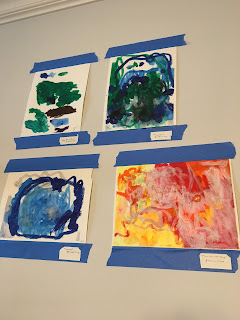The other day, I went to my cousin’s house for dinner and to hang out with his two adorable kids. Above the kitchen table hung four finger paintings done by his 3-year-old son, Clayton. Upon closer inspection, the paintings were labeled with names and price tags, examples of which include “Time Out” ($1.28mil USD) and “Abby Ate My Peas” ($550,000 USD). See the genius for yourself below.
It got me thinking that some of the works here were not so different than some things I’ve seen in the various modern art museums I've had the privilege of visiting. Granted, I’m not a huge appreciator of art, but seriously, Jackson Pollock?? How hard is it to recruit some naked women to roll around in paint on a canvas? Clay’s finger-painting technique may not have been backed by decades of motor skill experience or international fame, but the result looks, at the risk of sounding uncultured, pretty darn similar to me.
Hence my interest in the subject of child prodigies. In doing some minimal research, I stumbled across Aelita Andre, a young artist who had her first solo exhibition in 2009. What makes her so special? She was born in 2007.
So why is one two-year-old’s art more valuable than another’s? How much of the creative genius seen here is due to value placed rather than value earned?

Malcolm Gladwell’s article titled “Late Bloomers” explores the differences in creatives who begin their careers early with those who find fame later in life. Aelita’s case follows many of the patterns Gladwell comments upon for child prodigies. Her art is not carefully planned, but an outflow or expression of a moment rather than a meticulous ongoing process as is the case with many so-called "late bloomers." She also has the advantage of being able to create full time while still supported by her parents, who are also both artistically inclined and fully encourage her talents. Many adults cannot commit so much time to their art, as they must work to support themselves and their families. Aelita's website, obviously ghostwritten, presents her as a sort of child genius, and is likely reflective of the sorts of things she hears in her daily life.
Clearly I’m not the only one who has doubts about the artistic values of her works. The New York Times published this article (http://www.nytimes.com/2011/06/12/opinion/12horowitz.html) in 2011 that describes Aelita as “a piece of theater” with a “circus encircling her.” This video (https://www.youtube.com/watch?v=J24NRbFuynE) denounces the worth of her artwork and criticizes those who buy it. Though I tend to agree with both of these reactions, I also see two real creatives here: Aelita’s parents. They have capitalized on an opportunity not only to make money, but to bring fame to their family and support their child’s dreams from a very early age. Whether this will benefit Aelita later in life or will ultimately prove to be a form of exploitation remains to be seen, but for now, they’re enjoying the ride.
Sources:

No comments:
Post a Comment
Note: Only a member of this blog may post a comment.